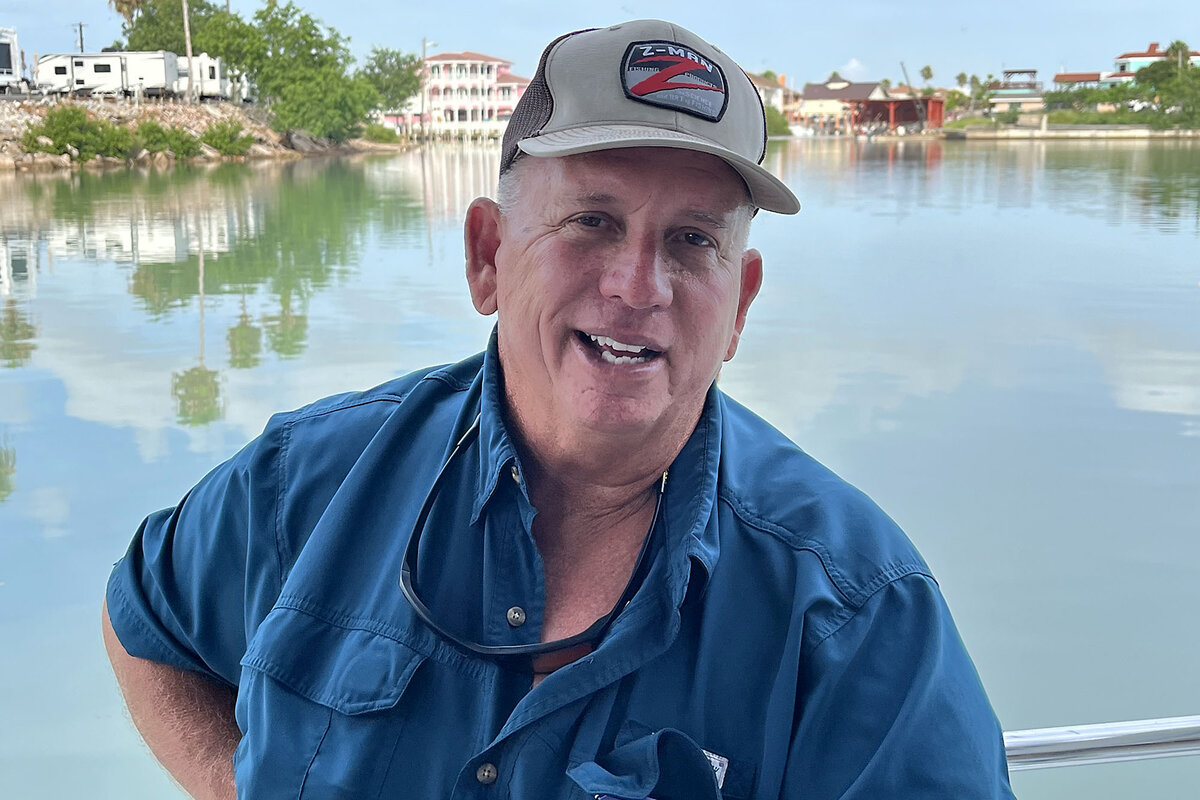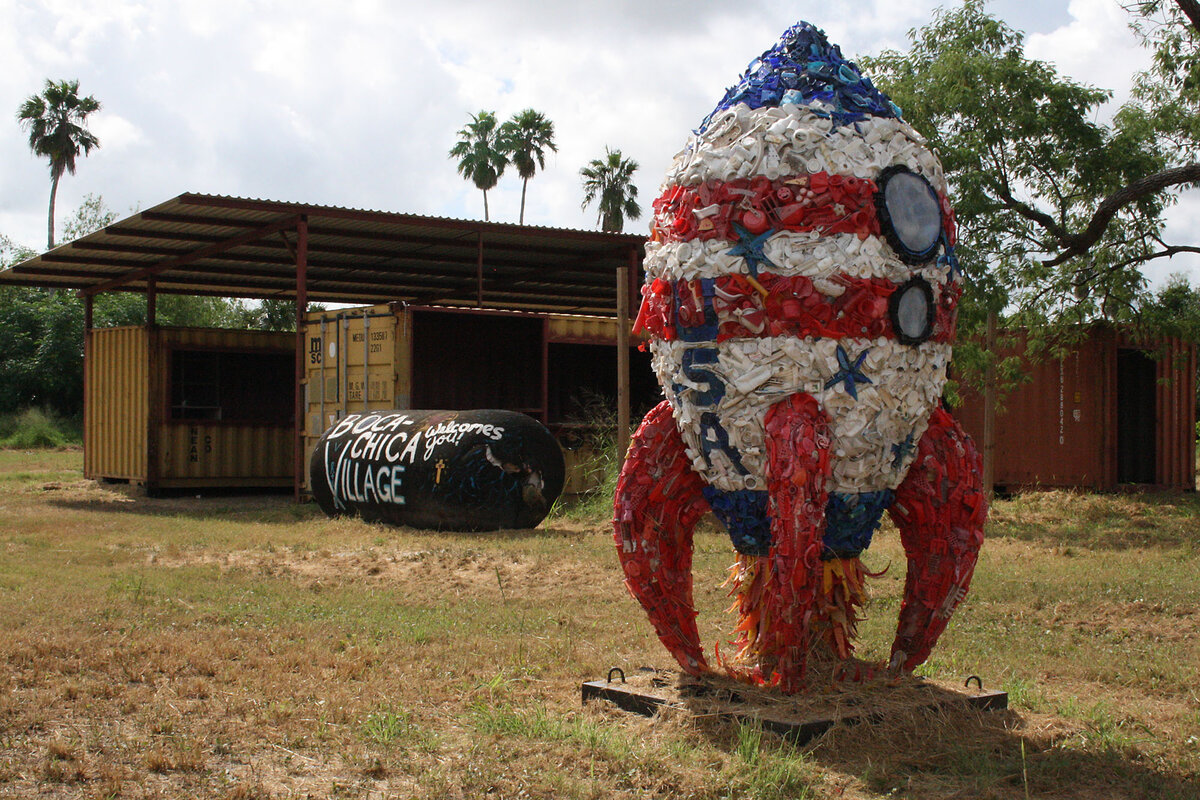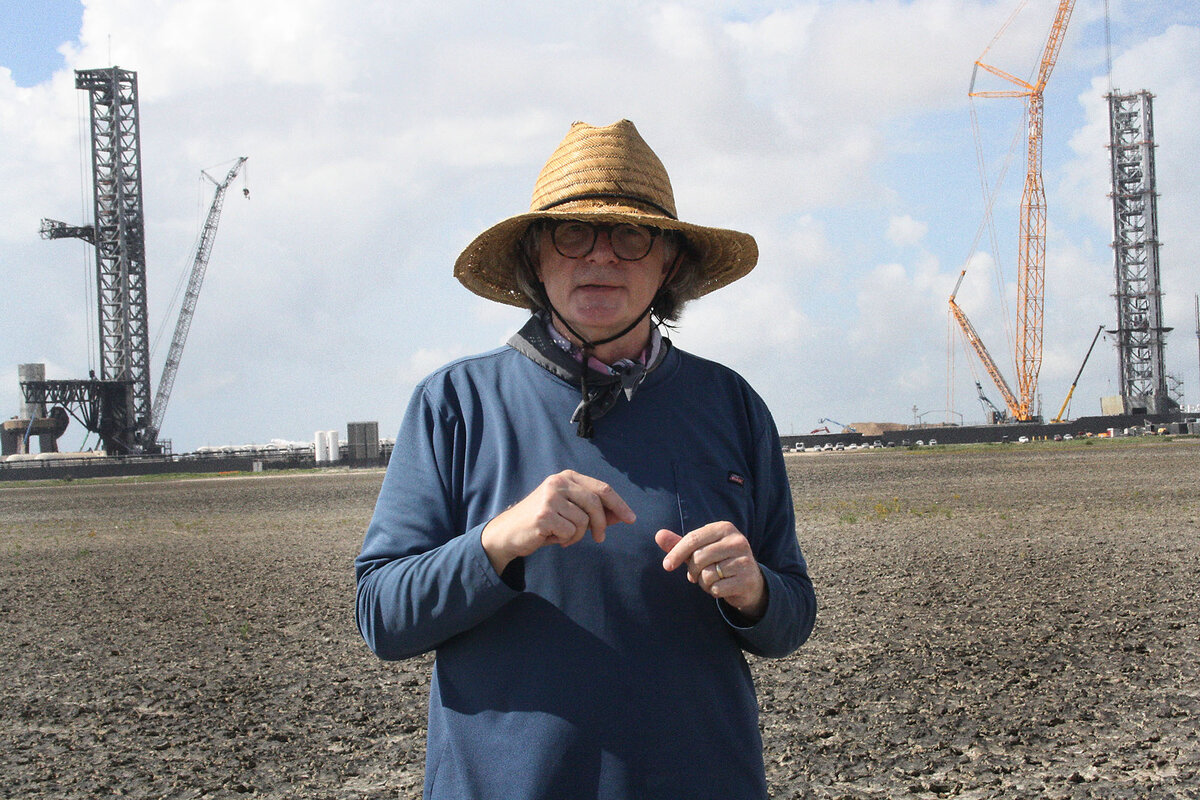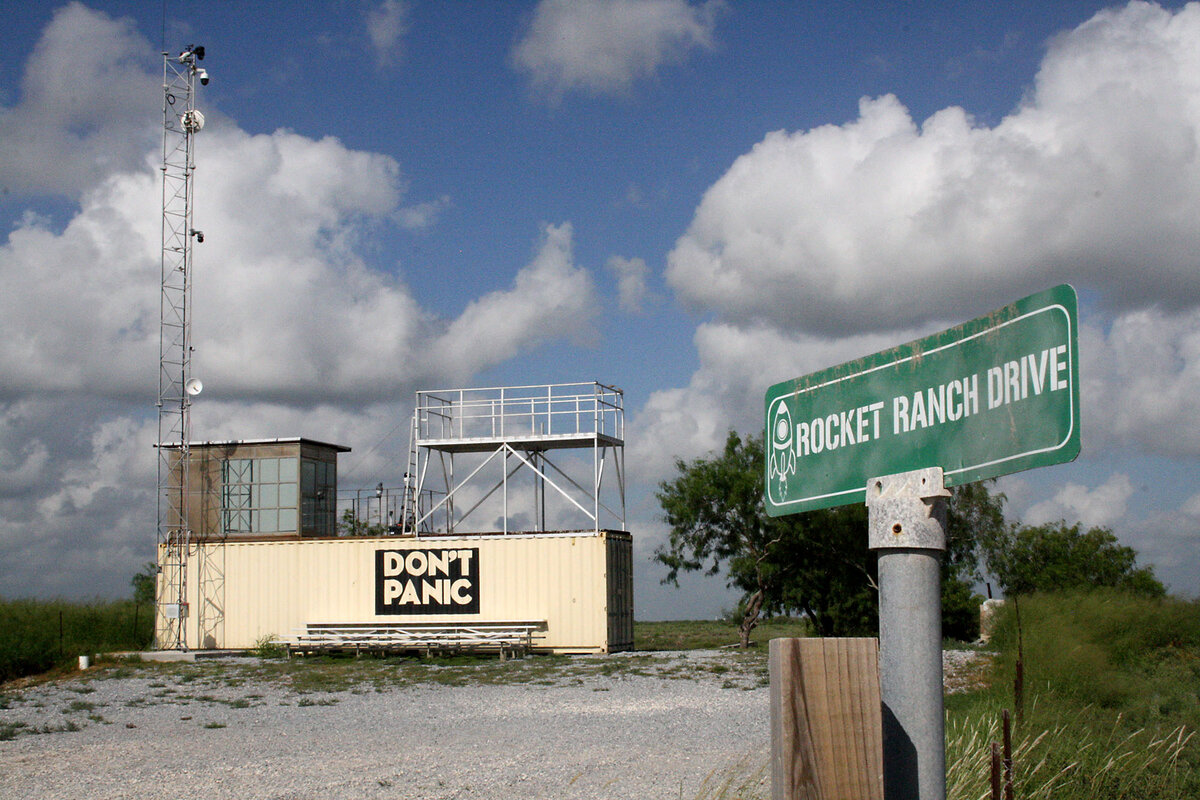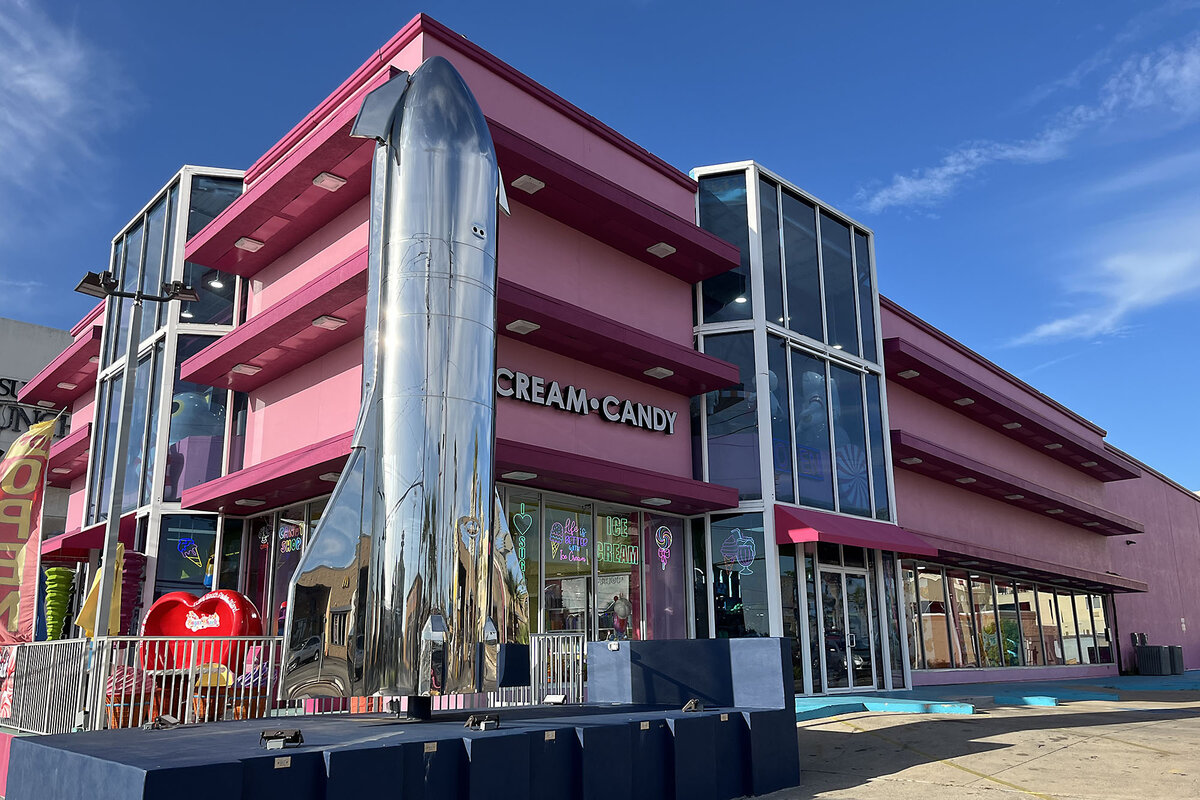SpaceX has Texas-scale ambitions in the sky. But they’re creating tensions on Earth.
Loading...
| BOCA CHICA, Texas
Charter fisher Cliff Fleming has spent most of his adult life here on the southern tip of Texas, making his living off the area’s abundant natural resources.
But now he has a lucrative side business: taking tourists out for fishing and a clear view of SpaceX rocket launches. He calls it a “blast and cast.”
Having a space company next door hasn’t exactly been smooth sailing. Last April, a cloud of concrete dust blanketed his boat – the result of a postlaunch “rapid unscheduled disassembly” (in laypeople’s terms, an explosion).
Why We Wrote This
A story focused onAs SpaceX transforms the Gulf Coast towns near its Starbase launch site, Texas is fast becoming the capital of the private space industry. For locals, the excitement and innovation blend with concerns for the area’s unique ecosystem.
Still, Captain Fleming says that he loves having SpaceX as a neighbor.
On Sunday, the private space company owned by billionaire Elon Musk conducted the latest flight test of its Starship rocket here in Boca Chica. For some residents like Captain Fleming, there has never been a more exciting time to live here.
SpaceX is now seeking permission starting next year to conduct up to 25 launches – and landings – of the Starship/Super Heavy, a mammoth rocket system designed to reach Mars.
But the company’s plans have been disrupted by a series of lawsuits and regulatory issues, particularly around potential environmental damage. Starbase is surrounded by a protected wildlife habitat that attracts hundreds of millions of dollars annually in ecotourism as a popular waypoint for migratory birds and home to dolphins, pelicans, and endangered sea turtles.
The test on Sunday included the milestone achievement of safely returning the Super Heavy rocket to the launchpad. It had been repeatedly delayed due to a variety of lawsuits by environmental groups and others against the company claiming that launches have spilled toxic wastewater into nearby waterways.
Still, while some voice concerns about what a more active SpaceX presence could mean for local communities, objections are largely eclipsed by excitement about the company’s potential.
Residents living in Starbase’s shadow say they feel like they’re in the middle of something incredible and at the start of something historic. Private companies like SpaceX are becoming integral to space exploration, they say, and this area – and Texas as a whole – could become central to the growing commercial space industry.
“I’m just a small part of that, but everybody benefits from it,” says Captain Fleming.
“Maybe it is a long-term problem,” he adds, referring to the potential environmental damages. But “Everybody benefits when those things take off.”
Martian-mania – for some
Ten years after setting up at the end of Highway 4 in Boca Chica, SpaceX is visible everywhere you look in coastal towns near the border city of Brownsville, Texas. Miniature metal Starships stand outside stores on South Padre Island. At a Port Isabel restaurant, you can order an “Occupy Mars omelet.” A local school district changed its mascot last year to the Rockets.
But along with the enthusiasm has come doubt, especially among residents concerned about collateral damage caused by this immense scientific endeavor. Clouds of dust and grime settled over Port Isabel after two previous Starship launches. A 2022 rocket engine test sparked a 68-acre fire in a neighboring wildlife refuge, home to nesting white-winged doves, egrets, and the threatened snowy plover.
There are also worries that a water deluge system under the launchpad, which sprays over 200,000 gallons of water during a launch to suppress the heat and noise of the Super Heavy booster’s 33 engines, is polluting waterways used by native turtles and dolphins, as well as fish that people catch and eat.
Critics also argue that the Starship rocket with its Super Heavy booster has never, in fact, been properly permitted.
When the U.S. Federal Aviation Administration (FAA) first approved the Starbase site in 2013, it studied potential environmental impacts from launches of the Falcon 9 and Falcon Heavy rockets “and a variety of reusable suborbital launch vehicles.”
Then, in 2018, Mr. Musk announced that the site would be dedicated to launches of the much larger Starship. Big enough for a Falcon 9 to fit inside it, the Starship is the most powerful rocket ever built.
Yet the FAA hasn’t completed an environmental impact statement since 2013, agreeing with SpaceX that shorter and more limited assessments before each launch test are sufficient.
But since the agency required a more in-depth study of the potential impacts of launching the 1,566-ton Falcon Heavy rocket, critics say they should do the same for the more than 4,000-ton Starship-Super Heavy.
Every Starship launch “represent[s] a rocket being fired here that was never, ever meant to be fired here, and has not been assessed to be fired here,” says Ken Saxon, a board member of Save RGV, an environmental group opposing industrial development in the Rio Grande Valley.
Permits, penalties, and potential impacts
This is particularly important, critics add, when SpaceX keeps adding new features to its launches. The water deluge system only came in last year, and the fifth Starship launch tested, for the first time, the launch tower’s ability to “catch” the Super Heavy as the booster returned to Earth seven minutes after launch.
Critical to making the Starship system reusable and efficient, the catch maneuver raises new potential regulatory questions, including the effects of deceleration engine burns and sonic booms, thunderlike noises created when an object travels through the air faster than the speed of sound.
In mid-August, the Texas Commission on Environmental Quality sanctioned the company over its water deluge system. The commission’s case alleged that thousands of gallons of water runoff from the system, containing pollutants like cyanide, copper, and chromium, have spilled into sensitive local waterways, according to government documents obtained by NPR. Months earlier, the U.S. Environmental Protection Agency had told the company the same system was operating in violation of federal law.
There are also at least five ongoing lawsuits against SpaceX operations in Boca Chica. Meanwhile, the company just filed its own lawsuit against California, accusing a state agency of being opposed to Mr. Musk’s politics rather than having substantive reasons for rejecting an increase in launches there.
Federal regulators, for their part, say the company’s desire for fast-paced testing and design changes makes it difficult for them to evaluate potential impacts and issue new permits.
Nevertheless, the FAA sped up its processes to ensure the fifth Starship test could go ahead on Sunday in Texas. It’s still unclear, however, if the agency will approve up to 25 launches and landings in the state starting next year.
Frequent tests and design changes are central to the company’s philosophy, and with NASA hoping to use Starship as part of its mission to return humans to the moon in 2026, the company needs to perfect the system as soon as possible.
SpaceX did not respond to multiple requests for comment, but in a lengthy statement released in September, the company said it has always had government permission to continue operating.
The two agency actions “are entirely tied to disagreements over paperwork,” the company said. “The narrative that we operate free of, or in defiance of, environmental regulation is demonstrably false.”
The private space boom
The delays are as frustrating for some locals – even those who’ve had disputes with the company – as they are for the company.
Maria Pointer retired here with her husband in 2015. Moving into the last house at the end of Highway 4, the Alaska native fell in love with what she calls her “wilderness.”
Then SpaceX moved in next door, and within a few years, the company started expanding and wanted their property. In 2020, after some reportedly tense negotiations, SpaceX bought out the Pointers.
They still live in the area, and Mrs. Pointer has built a popular YouTube channel documenting rocket tests. While it was challenging, she believes their move will be for the greater good.
“It sadden[s] me to think so many people [can’t] be happy for the future that’s coming,” she says. “If we’re going to hold back the space industry, we’re going to hold back the world.”
Indeed, commercial space companies are becoming central to a modern-day space race.
As it’s become cheaper to build and launch satellites, it’s become more profitable selling satellite and data services that come with launching things into orbit. As a result, private companies like SpaceX, Boeing, and Blue Origin – created by Amazon founder Jeff Bezos – are finding new and innovative ways to access low Earth orbit, a region just above the planet’s atmosphere.
From public to private space ventures
SpaceX and Boeing have contracted with NASA since 2014 to shuttle crews to the International Space Station. Mr. Musk’s company is also helping the agency with its Artemis program to return humans to the moon and is developing a spacecraft to deorbit (and thus decommission) the space station. At least a half-dozen private companies plan to launch their own space stations in the coming decades.
The space industry is projected to be worth $1.8 trillion by 2035, according to the World Economic Forum. Companies are thinking not just about the services they could provide, like deploying satellites and shuttling crews to and from Earth. They also see long-term profit in space tourism, research, and manufacturing in low Earth orbit, and asteroid mining, among other possibilities.
Issues remain, as evidenced by Boeing’s Starliner stranding two astronauts on the space station this year.
But the private sector is on the right track, according to Scott Pace, director of the Space Policy Institute at the George Washington University Elliott School of International Affairs.
“They’re innovating and working fast in a way you haven’t seen since the early days of Apollo,” says Dr. Pace. “Going deeper into space, operating on the lunar surface and beyond, are the next stages.”
Looking for sonic – and economic – booms
Texas wants to be at the forefront of this private sector boom.
The Lone Star State has been a leading player in U.S. spaceflight for decades, and it has nurtured the growing private space industry as well. Starbase is one of four spaceports in the state – only Florida, with six, has more – and is home to 18 of the 20 largest aerospace manufacturing companies in the world, according to Texas 2036, a nonpartisan public policy think tank.
Earlier this year, the state Legislature established the Texas Space Commission to boost the state’s commercial space industry. One hope is that it will benefit poor, isolated communities like Boca Chica, many of which have seen populations decline and poverty increase over the past decade.
Spaceflight by necessity operates in remote areas. The Blue Origin spaceport, for example, is in Van Horn, a West Texas town with about 2,000 people, just larger than the staff of an Amazon fulfillment center. While SpaceX has brought more jobs to surrounding Cameron County, locals say many new workers have come in from elsewhere. Fewer than 1 in 4 residents have a bachelor’s degree or higher, according to Census Bureau data.
“I would like to see the valley be more than just a tourist destination,” says Teviet Creighton, a professor at the University of Texas Rio Grande Valley in nearby Brownsville. “Being the next major technological innovation region is what we aspire to; that’s the dream.”
Can industry, science and nature coexist?
Driving down Highway 4, Mr. Saxon points out lomas – small hills of brush and trees that form over centuries in wetlands – off the side of the road. This stretch of road is one of only three places in the world where lomas can still be found. Other rare sightings here include migratory birds and sea turtles nest.
While launching rockets is exciting, and the possibility of human travel to Mars may inspire, the unique ecosystem in this corner of South Texas is just as captivating, he says.
“It’s a flaw that we have not got people interested [in] what this nature offers them,” he says. “People are taking pleasure in SpaceX ... but all of that is in nature a million times over.”
Some supporters believe that SpaceX’s growth here can coexist with the unique ecosystem.
They point to another launch site: Cape Canaveral, on Florida’s Atlantic coast. The NASA-operated complex is the most active spaceport in the United States, and it borders the Merritt Island National Wildlife Refuge. Established along with the space center in the early 1960s, the wildlife refuge hosts over 1,500 species of plants and animals, including 15 threatened and endangered species.
“In some sense, having [SpaceX] anchored there actually provides some protection,” says Dr. Creighton of the Texas hub. “No one else is going to build a subdivision or a factory within a few miles of a launch site.”
There are also the intangible benefits of space travel to consider. The Apollo missions inspired a generation to believe it could touch the stars. As profitable as the private space industry may become, the transcendent appeal of cosmos may be its most valuable asset.
“No one is thinking about partisan politics or polarization when a Starship lifts off,” says Dr. Pace. “Space is something that can unite people, bring us together. It’s something to feel positive about, and I think we need that.”
Editor's note: This article was updated on Oct. 16 to add a sentence on a new lawsuit over SpaceX launch plans in California.






